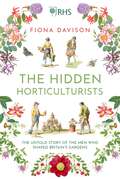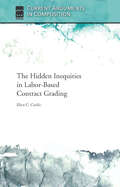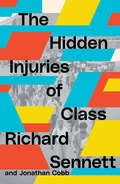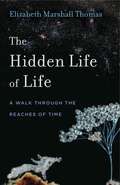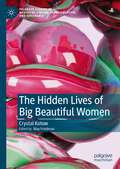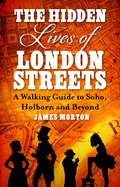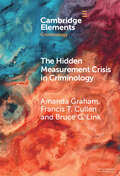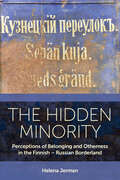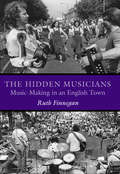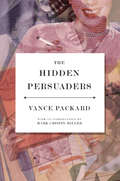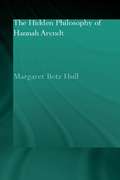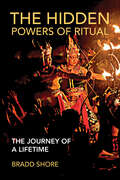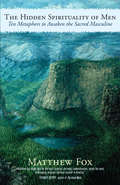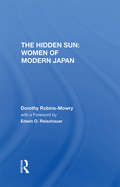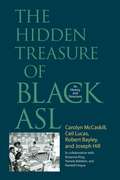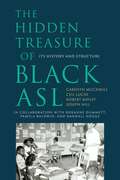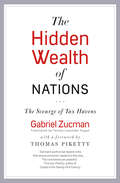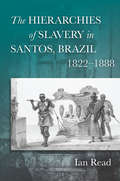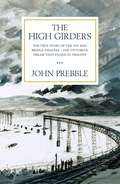- Table View
- List View
The Hidden Horticulturists: The Untold Story of the Men Who Shaped Britain's Gardens
by Fiona DavisonIn 2012, while working at the Royal Horticultural Society's library, Fiona Davison unearthed a book of handwritten notes that dated back to 1822. The notes, each carefully set out in neat copperplate writing, had been written by young gardeners in support of their application to be received into the Society's Garden. Among them was an entry from the young Joseph Paxton, who would go on to become one of Britain's best-known gardeners and architects. But he was far from alone, and now, for the first time, the stories of the young, working-class men who also played a central role in the history of British horticulture can be told. Using their notes, Fiona Davison traces the stories of a selection of these forgotten gardeners whose lives would take divergent paths to create a unique history of gardening. The trail took her from Chiswick to Bolivia and uncovered tales of fraud, scandal and madness—and, of course, a large number of fabulous plants and gardens. This is a celebration of the unsung heroes of horticulture whose achievements reflect a golden moment in British gardening, and continue to influence gardeners today..
The Hidden Inequities in Labor-Based Contract Grading (Current Arguments in Composition)
by Ellen C. CarilloCurrent Arguments in Composition Series The Hidden Inequities in Labor-Based Contract Grading intervenes in the increasingly popular practice of labor-based grading by expanding the scope of this assessment practice to include students who are disabled and multiply marginalized. Through the lens of disability studies, the book critiques the assumption that labor is a neutral measure by which to assess students and explores how labor-based grading contracts put certain groups of students at a disadvantage. Ellen C. Carillo offers engagement-based grading contracts as an alternative that would provide a more equitable assessment model for students of color, those with disabilities, and students who are multiply marginalized. This short book explores the history of labor-based grading contracts, reviews the scholarship on this assessment tool, highlights the ways in which it normalizes labor as an unbiased tool, and demonstrates how to extend the conversation in new and generative ways both in research and in classrooms. Carillo encourages instructors to reflect on their assessment practices by demonstrating how even assessment methods that are designed through a social-justice lens may unintentionally privilege some students over others.
The Hidden Injuries of Class
by Richard Sennett Jonathan CobbHow to find dignity and a meaningful life in the modern cityIn this reissue of the 1972 classic of social anatomy, Richard Sennets adds a new introduction to shows how the injuries of class persist into the 21st century. In this intrepid, groundbreaking book, Richard Sennett and Jonathan Cobb uncover and define a new form of class conflict in America an internal conflict in the heart and mind of the blue-collar worker who measures his own value against those lives and occupations to which our society gives a special premium. The authors conclude that in the games of hierarchical respect, no class can emerge the victor; and that true egalitarianism can be achieved only by rediscovering diverse concepts of human dignity. Examining personal feelings in terms of a totality of human relations, and looking beyond the struggle for economic survival, The Hidden Injuries of Class takes an important step forward in the sociological critique of everyday life.
The Hidden Language of Graphic Signs: Cryptic Writing and Meaningful Marks
by John Bodel Stephen HoustonA common belief is that systems of writing are committed to transparency and precise records of sound. The target is the language behind such marks. Readers, not viewers, matter most, and the most effective graphs largely record sound, not meaning. But what if embellishments mattered deeply - if hidden writing, slow to produce, slow to read, played as enduring a role as more accessible graphs? What if meaningful marks did service alongside records of spoken language? This book, a compilation of essays by global authorities on these subjects, zeroes in on hidden writing and alternative systems of graphic notation. Essays by leading scholars explore forms of writing that, by their formal intricacy, deflect attention from language. The volume also examines graphs that target meaning directly, without passing through the filter of words and the medium of sound. The many examples here testify to human ingenuity and future possibilities for exploring enriched graphic communication.
The Hidden Life of Life: A Walk through the Reaches of Time (Animalibus)
by Elizabeth Marshall ThomasAn iconoclast and best-selling author of both nonfiction and fiction, Elizabeth Marshall Thomas has spent a lifetime observing, thinking, and writing about the cultures of animals such as lions, wolves, dogs, deer, and humans. In this compulsively readable book, she provides a plainspoken, big-picture look at the commonality of life on our planet, from the littlest microbes to the largest lizards.Inspired by the idea of symbiosis in evolution—that all living things evolve in a series of cooperative relationships—Thomas takes readers on a journey through the progression of life. Along the way she shares the universal likenesses, experiences, and environments of “Gaia’s creatures,” from amoebas in plant soil to the pets we love, from proud primates to Homo sapiens hunter-gatherers on the African savanna. Fervently rejecting “anthropodenial,” the notion that nonhuman life does not share characteristics with humans, Thomas instead shows that paramecia can learn, plants can communicate, humans aren’t really as special as we think we are—and that it doesn’t take a scientist to marvel at the smallest inhabitants of the natural world and their connections to all living things.A unique voice on anthropology and animal behavior, Thomas challenges scientific convention and the jargon that prevents us all from understanding all living things better. This joyfully written book is a fascinating look at the challenges and behaviors shared by creatures from bacteria to larvae to parasitic fungi, a potted hyacinth to the author herself, and all those in between.
The Hidden Life of Life: A Walk through the Reaches of Time (Animalibus: Of Animals and Cultures #13)
by Elizabeth Marshall ThomasAn iconoclast and best-selling author of both nonfiction and fiction, Elizabeth Marshall Thomas has spent a lifetime observing, thinking, and writing about the cultures of animals such as lions, wolves, dogs, deer, and humans. In this compulsively readable book, she provides a plainspoken, big-picture look at the commonality of life on our planet, from the littlest microbes to the largest lizards.Inspired by the idea of symbiosis in evolution—that all living things evolve in a series of cooperative relationships—Thomas takes readers on a journey through the progression of life. Along the way she shares the universal likenesses, experiences, and environments of “Gaia’s creatures,” from amoebas in plant soil to the pets we love, from proud primates to Homo sapiens hunter-gatherers on the African savanna. Fervently rejecting “anthropodenial,” the notion that nonhuman life does not share characteristics with humans, Thomas instead shows that paramecia can learn, plants can communicate, humans aren’t really as special as we think we are—and that it doesn’t take a scientist to marvel at the smallest inhabitants of the natural world and their connections to all living things.A unique voice on anthropology and animal behavior, Thomas challenges scientific convention and the jargon that prevents us all from understanding all living things better. This joyfully written book is a fascinating look at the challenges and behaviors shared by creatures from bacteria to larvae to parasitic fungi, a potted hyacinth to the author herself, and all those in between.
The Hidden Lives of Big Beautiful Women (Palgrave Studies in Mediating Kinship, Representation, and Difference)
by Crystal KotowThis book is a deep dive into the largely unexplored space of BBW “bashes”—multi-day gatherings of fat women and their admirers. Using a range of feminist theories of embodiment and affect, the project is guided by autoethnography and in-depth interviews with twelve participants. Participant experiences are first analyzed with a key focus on experiences that cause grief and disenfranchisement; subsequently, the book looks at experiences that may be radical or revelatory. The book does not seek to either villainize or valorize BBW spaces but instead sheds a bright light on the experience of this cultural subspace and all it may offer to analyses of fat life.
The Hidden Lives of London Streets: A Walking Guide to Soho, Holborn and Beyond
by James MortonLondon's streets have always worn a variety of influences, reflecting the diverse crowds who live and work on them. Take a walk down any number of historic streets and an abundance of tales exist in the bricks and mortar, waiting to be told. The Hidden Lives of London's Streets takes the reader on a journey through Soho, Piccadilly, Mayfair, Knightsbridge, Chelsea, Kensington, Fitzrovia and Clerkenwell. A street map is provided for each area, marking out the streets and buildings in which the various activities - some forgotten, others well-remembered - took place.Stories include those of courtesans such as the notorious Lola Montez and Theresa de Cornelys, who gave lavish balls at their home in Soho Square which were little more than orgies, during which a man playing the violin while on roller skates crashed through her plate glass window; Casanova and his quarrel with Marianne Charpillon after he taught a parrot to say she was a 'whore'; clubs - great (the Gargoyle), the artistic (Muriel Belcher's Colony), and the small (Royston Smith's club for dwarves); the police; robberies; murder and executions; the nightclubs; cinemas and theatres; the villains and prostitution. Beyond mere gangs and criminality, the book will trace the social changes that have gradually unfolded on any given street. For example the metamorphosis of Old Compton Street as home to race gangs in the 1920s, to becoming an essentially Italian street, to being part of the gay community.
The Hidden Lives of London Streets: A Walking Guide to Soho, Holborn and Beyond
by James MortonLondon's streets have always worn a variety of influences, reflecting the diverse crowds who live and work on them. Take a walk down any number of historic streets and an abundance of tales exist in the bricks and mortar, waiting to be told. The Hidden Lives of London's Streets takes the reader on a journey through Soho, Piccadilly, Mayfair, Knightsbridge, Chelsea, Kensington, Fitzrovia and Clerkenwell. A street map is provided for each area, marking out the streets and buildings in which the various activities - some forgotten, others well-remembered - took place.Stories include those of courtesans such as the notorious Lola Montez and Theresa de Cornelys, who gave lavish balls at their home in Soho Square which were little more than orgies, during which a man playing the violin while on roller skates crashed through her plate glass window; Casanova and his quarrel with Marianne Charpillon after he taught a parrot to say she was a 'whore'; clubs - great (the Gargoyle), the artistic (Muriel Belcher's Colony), and the small (Royston Smith's club for dwarves); the police; robberies; murder and executions; the nightclubs; cinemas and theatres; the villains and prostitution. Beyond mere gangs and criminality, the book will trace the social changes that have gradually unfolded on any given street. For example the metamorphosis of Old Compton Street as home to race gangs in the 1920s, to becoming an essentially Italian street, to being part of the gay community.
The Hidden Measurement Crisis in Criminology: Procedural Justice as a Case Study (Elements in Criminology)
by Francis T. Cullen Amanda Graham Bruce G. LinkThe field of criminology is limited by a 'hidden' measurement crisis. It is hidden because scholars either are not aware of the shortcomings of their measures or have implicitly agreed that scales with certain properties merit publication. It is a crisis because the approaches used to construct measures do not employ modern systematic psychometric methods. As a result, the degree to which existing measures have methodological limitations is unknown. The purpose of this Element is to unmask this hidden crisis and provide a case study demonstrating how to build a measure of a prominent criminological construct through modern systematic psychometric methods. Using multiple surveys and item response theory, it develops a ten-item scale of procedural justice in policing. This can be used in primary research and to adjudicate existing measures. The goal is to reveal the nature of the field's measurement crisis and show a strategy for solving it.
The Hidden Minority: Perceptions of Belonging and Otherness in the Finnish – Russian Borderland (EASA Series #52)
by Helena JermanLooking at the Finnish–Russian borderland as a transnational space and claiming that there is a need to understand the long-term effects of migration – a continuing process spanning several generations – The Hidden Minority takes a multi-temporal perspective on mobility and belonging. The focus of this ethnographic study is the Russian minority in Finland, which is socially, economically, politically and culturally heterogeneous.The Russian minority in Finland is imbued with ’being hidden‘ or ’hiding oneself‘. The book explores informants’ reflections, together with the author, on the mental and physical crossing of national borders. Perceptions of belonging and/or Otherness and lived experience reveal a complex relationship of embodied memory, history, time and a multi-national social space.
The Hidden Musicians: Music-Making in an English Town (Music Culture)
by Ruth FinneganA landmark in the study of music and culture, this acclaimed volume documents the remarkable scope of amateur music-making in the English town of Milton Keynes. It presents in vivid detail the contrasting yet overlapping worlds of classical orchestras, church choirs, brass bands, amateur operatic societies, and amateur bands playing jazz, rock, folk, and country. Notable for its contribution to wider theoretical debates and its influential challenge to long-held assumptions about music and how to study it, the book focuses on the practices rather than the texts or theory of music, rejecting the idea that only selected musical traditions, "great names," or professional musicians are worth studying. This opens the door to the invisible work put in by thousands of local people of diverse backgrounds, and how the pathways creatively trodden by amateur musicians have something to tell us about both urban living and what it is to be human. Now with a new preface by the author, this long-awaited reissue of The Hidden Musicians will bring its insights and innovations to a new generation of students and scholars.
The Hidden Persuaders
by Mark Crispin Miller Vance Packard"One of the best books around for demystifying the deliberately mysterious arts of advertising."--Salon"Fascinating, entertaining and thought-stimulating."--The New York Times Book Review"A brisk, authoritative and frightening report on how manufacturers, fundraisers and politicians are attempting to turn the American mind into a kind of catatonic dough that will buy, give or vote at their command--The New YorkerOriginally published in 1957 and now back in print to celebrate its fiftieth anniversary, The Hidden Persuaders is Vance Packard's pioneering and prescient work revealing how advertisers use psychological methods to tap into our unconscious desires in order to "persuade" us to buy the products they are selling.A classic examination of how our thoughts and feelings are manipulated by business, media and politicians, The Hidden Persuaders was the first book to expose the hidden world of "motivation research," the psychological technique that advertisers use to probe our minds in order to control our actions as consumers. Through analysis of products, political campaigns and television programs of the 1950s, Packard shows how the insidious manipulation practices that have come to dominate today's corporate-driven world began. Featuring an introduction by Mark Crispin Miller, The Hidden Persuaders has sold over one million copies, and forever changed the way we look at the world of advertising.Vance Packard (1914-1996) was an American journalist, social critic, and best-selling author. Among his other books were The Status Seekers, which described American social stratification and behavior, The Waste Makers, which criticizes planned obsolescence, and The Naked Society, about the threats to privacy posed by new technologies.
The Hidden Philosophy of Hannah Arendt (Routledge Jewish Studies Series)
by Margaret Betz HullThe central argument of this book is that Hannah Arendt's deserved place in the history of Western philosophy has been overlooked, and recognition of her contribution is long overdue. In part a result of Arendt's own insistence on calling herself a 'political thinker' throughout her career, this is also due to a common tendency in philosophy to denigrate the political. This book explores the indisputable philosophical dimensions of her work. In particular, it examines Arendt's theoretical commitment to recognizing humanity as a plurality, which avoids the common mistake in Western philosophy of theoretically overemphasizing the self in isolation. Arendt's own personal dealings with aspects of her identity, namely her Jewishness and her womanhood, work to inform us of this position against solipsism.
The Hidden Powers of Ritual: The Journey of a Lifetime
by Bradd ShoreAn illuminating overview of the development, benefits, and importance of ritual in everyday life, written by a leading cognitive anthropologist.The Hidden Powers of Ritual is an engaging introduction to ritual studies that presents ritual as an evolved form of human behavior of almost unimaginable significance to our species. Every day across the globe, people gather to share meals, brew caffeinated beverages, or honor their ancestors. In this book, Bradd Shore, a respected anthropologist, reaches beyond familiar &“big-R&” rituals to present life&’s humbler, overshadowed moments, exploring everything from the Balinese pelebon to baseball to family Zoom sessions in the age of Covid to the sobering reenactment rituals surrounding the Moore&’s Ford lynchings. In each ritual, Shore shows how our capacity to ritualize behavior is a remarkable part of the human story.Encompassing both the commonly unlabeled &“interaction rituals&” studied by sociologists and the symbolically elaborated sacred rituals of religious studies, Shore organizes his conception around detailed case studies drawn from international research and personal experience, weaving scholarship with a memoir of a life encompassed by ritual. A probing exploration that matches breadth with accessibility, The Hidden Powers of Ritual is a provocative contribution to ritual theory that will appeal to a wide range of readers curious about why these unique repetitive acts matter in our lives.
The Hidden Screen: Low Power Television in America
by Michael C. Keith Robert L. HilliardThis text explores the industry of low-power television (LPTV) in America. It covers what LPTV is and how it got started, who the broadcasters are and their viewers, LPTV's significance in contemporary society and culture, and the challenges it faces in the late 1990s and the millennium.
The Hidden Spirituality of Men: Ten Metaphors to Awaken the Sacred Masculine
by Matthew FoxIt is no secret that men are in trouble today. From war to ecological collapse, most of the world’s critical problems stem from a distorted masculinity out of control. Yet our culture rewards the very dysfunctions responsible for those problems. To Matthew Fox, our crucial task is to open our minds to a deeper understanding of the healthy masculine than we receive from our media, culture, and religions. Popular religion forces the punitive imagery of fundamentalism on us, pushing most men away from their natural yearning for spirituality and toward intolerance and domination. Meanwhile, many men, particularly young men, are looking for images of healthy masculinity to emulate and finding nothing. To awaken what Fox calls “the sacred masculine,” he unearths ten metaphors, or archetypes, ranging from the Green Man, an ancient pagan symbol of our fundamental relationship with nature, to the Grandfatherly Heart to the Spiritual Warrior. He explores archetypes of sacred marriage, showing how partnership becomes the ultimate expression of healthy masculinity. By stirring our natural yearning for healthy spirituality, Fox argues, these timeless archetypes can inspire men to pursue their higher calling to reinvent the world.
The Hidden Sun: Women Of Modern Japan
by Dorothy Robins-mowryEver since Japan and the West discovered one another, Western observers have extolled the surface virtues of Japanese women but attended very little to what they are really like. In this new, balanced view of the role of Japanese women in their country's swiftly changing society, Dr. Robins-Mowry destroys the Western stereotype of the shy, perhaps
The Hidden Treasure Of Black ASL: Its History And Structure
by Ceil Lucas Robert Bayley Joseph Hill Carolyn McCaskill Pamela Baldwin Roxanne Dummet-King Randall HoguePeople who first encounter sign language often ask if deaf people around the world sign the same language. Frequently, they are surprised to learn that there are different sign languages in different nations worldwide, as well as variations of these languages. These variations depend on social factors such as region, age, gender, socioeconomic status, and race. One variation, Black ASL, has been recognized for years as a distinct form of sign language but only through anecdotal reports. This volume and its accompanying DVD present the first empirical study that begins to fill in the linguistic gaps about Black ASL. The powerful cast of contributors to The Hidden Treasure of Black ASL considered three questions in their study. First, what was the sociohistorical reality that made a separate variety of ASL possible? Second, what are the features of the variety of ASL that people call Black ASL? Third, can the same kind of unique features that have been identified in African American English be identified in Black ASL? This groundbreaking book and its companion DVD go far in answering these questions while also showing the true treasures of Black ASL.
The Hidden Treasure of Black ASL: Its History and Structure
by Ceil Lucas Robert Bayley Joseph Christopher Hill Carolyn McCaskillBlack ASL has long been recognized as a distinct variety of American Sign Language based on abundant anecdotal evidence. The Hidden Treasure of Black ASL, originally published in 2011, presents the first sociohistorical and linguistic study of this language variety. Based on the findings of the Black ASL Project, which undertook this unprecedented research, Hidden Treasure documents the stories and language of the African American Deaf community. With links to online supplemental video content that includes interviews with Black ASL users (formerly on DVD), this volume is a groundbreaking scholarly contribution and a powerful affirmation for Black Deaf people. This paperback edition includes an updated foreword by Glenn B. Anderson, a new preface that reflects on the impact of this research, and an expanded list of references and resources on Black ASL. The supplemental video content is available online at the Gallaudet University Press YouTube Channel. Under Playlists, click “The Hidden Treasure of Black ASL: Companion Video to the Book.” As featured in the film Signing Black in America: The Story of Black ASL, produced by The Language and Life Project at North Carolina State University (Dr. Walt Wolfram, Executive Producer). Look for it on PBS.
The Hidden Wealth of Nations: The Scourge of Tax Havens
by Gabriel ZucmanA &“masterful&” work that quantifies the cost of tax havens and large-scale tax evasion to ordinary citizens, and explores solutions to the problem (American Prospect). One much-discussed solution to the rapidly growing problem of economic inequality is to significantly increase the rate at which we tax the wealthy. But with an enormous amount of the world&’s wealth hidden in tax havens—in countries like Switzerland, Luxembourg, and the Cayman Islands—this wealth cannot be fully accounted for and taxed fairly. No one, from economists to bankers to politicians, has been able to quantify exactly how much of the world&’s assets are currently hidden—until now. Gabriel Zucman is the first economist to offer reliable insight into the actual extent of the world&’s money held in tax havens. And it&’s staggering. Fighting the notion that any attempts to vanquish tax havens are futile since some countries will always offer more advantageous tax rates than others, as well the counter-argument that tax havens have disappeared since the 2007–2008 global financial crisis, Zucman shows how both sides are actually very wrong. In The Hidden Wealth of Nations he offers an ambitious agenda for reform, focused on ways in which countries can change the incentives of tax havens. Only by first understanding the enormity of the secret wealth can we begin to estimate the kind of actions that would force tax havens to give up their practices. Zucman&’s work has quickly become the gold standard for quantifying the amount of the world&’s assets held in havens. In this concise book, he lays out in approachable language how the international banking system works and the dangerous extent to which the large-scale evasion of taxes is undermining the global market as a whole. If we are to find a way to solve the problem of increasing inequality, The Hidden Wealth of Nations is essential reading. &“Unusually lucid and elegant prose—particularly for an economist—complemented by an admirable grasp of history. His review of the ways that efforts to combat tax evasion have stalled for the past century makes the book a worthwhile read in and of itself. . . . Zucman is still at the beginning of what promises to be a brilliant career.&” ―The Atlantic
The Hidden Wound
by Wendell BerryWith the expected grace of Wendell Berry comes The Hidden Wound, an essay about racism and the damage it has done to the identity of our country. Through Berry's personal experience, he explains how remaining passive in the face of the struggle of racism further corrodes America's potential. In a quiet and observant manner, Berry opens up about how his attempt to discuss racism is rooted in the hope that someday the historical wound will begin to heal.
The Hierarchies of Slavery in Santos, Brazil, 1822-1888
by Ian ReadDespite the inherent brutality of slavery, some slaves could find small but important opportunities to act decisively. The Hierarchies of Slavery in Santos, Brazil, 1822-1888explores such moments of opportunity and resistance in Santos, a Southeastern township in Imperial Brazil. It argues that slavery in Brazil was hierarchical: slaves' fleeting chances to form families, work jobs that would not kill or maim, avoid debilitating diseases, or find a (legal or illegal) pathway out of slavery were highly influenced by their demographic background and their owners' social position. By tracing the lives of slaves and owners through multiple records, the author is able to show that the cruelties that slaves faced were not equally shared. One important implication is that internal stratification likely helped perpetuate slavery because there was the belief, however illusionary, that escaping captivity was not necessary for social mobility.
The High Girders: The gripping true story of a Victorian dream that ended in tragedy
by John Prebble'A tale of irresponsibility and inexperience' THE TIMES'Graphically written with a sense of dramatic construction' SCOTSMANOn December 28th 1879, the night of the Great Storm, the Tay Bridge collapsed, along with the train that was crossing, and everyone on board...This is the true story of that disastrous night, told from multiple viewpoints:The station master waiting for the train to arrive - who sees the approaching lights simply vanish.The bored young boys watching from their bedroom window who witness the disaster.The dreamer who designed the bridge which eventually destroyed him.The old highlanders who professed the bridge doomed from the outset.The young woman on the ill-fated train, carrying a love letter from the man she hoped to marry...THE HIGH GIRDERS is a vivid, dramatic reconstruction of the ill-omened man-made catastrophe of the Tay Bridge disaster - and its grim aftermath.
The High Girders: The gripping true story of a Victorian dream that ended in tragedy
by John Prebble'A tale of irresponsibility and inexperience' THE TIMES'Graphically written with a sense of dramatic construction' SCOTSMANOn December 28th 1879, the night of the Great Storm, the Tay Bridge collapsed, along with the train that was crossing, and everyone on board...This is the true story of that disastrous night, told from multiple viewpoints:The station master waiting for the train to arrive - who sees the approaching lights simply vanish.The bored young boys watching from their bedroom window who witness the disaster.The dreamer who designed the bridge which eventually destroyed him.The old highlanders who professed the bridge doomed from the outset.The young woman on the ill-fated train, carrying a love letter from the man she hoped to marry...THE HIGH GIRDERS is a vivid, dramatic reconstruction of the ill-omened man-made catastrophe of the Tay Bridge disaster - and its grim aftermath.
